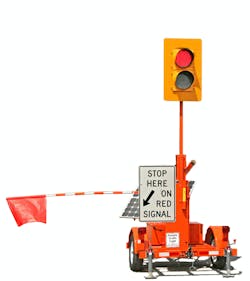Tunnel reconstruction creates a major challenge for airport emergency-response team
As part of a larger airport expansion, Walsh Construction is reconstructing an 1,800-ft-long service tunnel at a major airport located in the northern U.S. This four-lane tunnel is used by airport service personnel and, more importantly, the airport emergency response team. Due to the construction and expansion of the airport, this tunnel has been reduced to two lanes. In the event of an emergency, access to the tunnel must be immediately closed off to all service vehicles so that extra-wide emergency-response vehicles can have dedicated access to the tunnel, ensuring quick response times.
Walsh Construction elected to use two RC Flagman units (model RCF 2.4HD) on this project. The radios in the units omit the need to run temporary power lines or use a more costly flagging service to control traffic. The two units are set up at either end of the tunnel allowing for emergency response to stop traffic within an instant of when an emergency occurs.
In the event of an emergency, the units are put into an "All Stop" by the fire chief (using the radio remote control) while at the command center 1,200 ft from the master unit. When the master unit receives the signal from the chief's remote, it then sends an "All Stop" command through the tunnel to the secondary unit 1,800 ft away. Once the emergency-response vehicles clear the tunnel the fire chief initiates the “Proceed With Caution” sequence and changes the machines back to resume traffic flow.
There were two main obstacles to overcome with this project. The 1,800-ft tunnel made it difficult for the master and secondary units to maintain constant communication and the 1,200 ft between the command center and the master unit were just beyond the range for reliable communication. To overcome these obstacles, North America Traffic worked rigorously with airport engineers to find a solution that would allow for the extended distance while maintaining constant radio communication. A hardwire communication link was considered but was deemed to be impractical and costly as each RC Flagman unit would need to have an operator present to activate the "All Stop" for the emergency-response vehicles to pass. The second option that was considered was a repeater station. This would work by hopping the radio signal between the command center and the master and between the master and secondary units.
North America Traffic developed and implemented three repeater stations to create the reliable communication link needed for this project. Two repeater stations were positioned over the tunnel and one repeater station was placed in between the command center and the master unit at the entrance to the tunnel. This setup has enabled a constant signal communication between the equipment with 0% down time.
